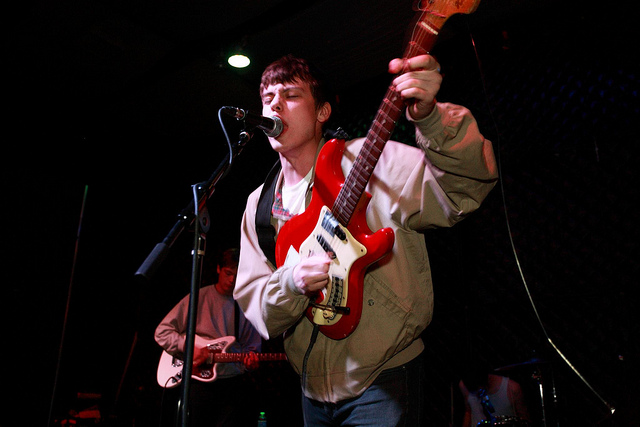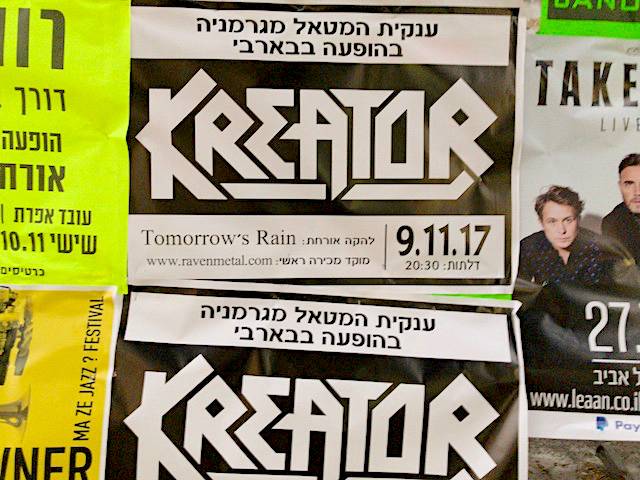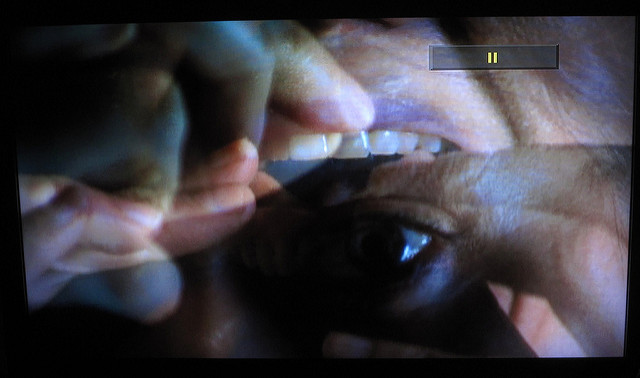If the mission of ’77 punk was the resuscitation of rock & roll’s antisocial roots, postpunk amounted to an unfettered exploration of the musical and cultural spaces that punk had made possible. In England’s Dreaming, Jon Savage noted that as early as 1978, punk had fractured into two camps: The social realists on one side (The Clash, Stiff Little Fingers) whose fans would become the street punk, Oi!, and hardcore movements. On the other side, a more arty crowd that was intrigued by Krautrock, modernism, Byronic romanticism, pre-punk artists like Roxy Music and David Bowie, and Malcolm MacLaren’s attempt at injecting Situationism into rock.
Simon Reynolds’ Rip It Up and Start Again (named after an Orange Juice song) places the classic era of postpunk from 1978 to 1984, and that’s exactly right. Although postpunk was not a cohesive movement -it was almost a type of shared, frustrated cultural zeitgeist – all of its bands existed at the same time, for largely the same reasons. As Reynolds points out, the punk-to-postpunk journey was typified by Johnny Rotten’s leaving three chord rock and roll behind to become John Lydon in Public Image Limited. That was the template. Warsaw became Joy Division, Howard Devoto left the Buzzcocks to start Magazine, Easy Cure became The Cure, Crisis became Death in June, and 1978 US hardcore pioneers Middle Class even turned to postpunk by 1982 (see their Homeland LP.)
The original postpunk movement was a direct outgrowth of punk, in other words. Postpunk was inextricably, foundationally tied to punk. Just as Clausewitz claimed war was politics by other means, so postpunk was initially punk attempted by other means, means created by punk’s liberatory nature. The Pop Group and Gang of Four were just as political as hardcore punks Dead Kennedys and MDC, but whereas the latter groups appealed through the power of breakneck speed, the former sought out non-traditional song structures and appealed through the power of unusual grooves, grooves inspired by funk, jazz, disco, dub, or genuinely weird musicians like Captain Beefheart.
The most expansive sense of the term “postpunk,” in fact, includes the DIY hardcore movement; the seminal 1978 Middle Class Out of Vogue EP is an experimental attempt at breaking the speed barrier that is just as avant-garde for its time as anything that came out of New York’s no wave movement. Straight-up postpunk bands like the Minutemen and The Urinals/100 Flowers are also generally lumped in with hardcore bands. The Dead Kennedys would open for UK Decay while Minor Threat covered a song by Wire. The boundaries blur the closer you look.
Unfortunately, nowadays, when mainstream magazines like SPIN refer to a contemporary postpunk revival, they are not referring to bands that have grown directly out of any punk scene the way the original postpunk bands did. As Simon Reynolds wrote in a recent piece, “Today’s remake/remodel squad – Bloc Party, Franz Ferdinand, Futureheads, etc – operate from a rather narrow notion of post-punk.” The direct touchstones for these bands are not the Sex Pistols or The Stranglers, as was the case with the original postpunk bands; in fact, it’s more likely that younger, mainstream “postpunk” bands’ foundational groups are bands like Radiohead, or acts from the 1990s Britpop and shoegaze scenes. There’s nary any punk to be found in these bands’ collective “postpunk” equation.
So, this is a survey not about that “new postpunk” (in the sense of Interpol or She Wants Revenge) movement. It’s about the current crop of postpunk bands that, like the original 1978-1984 postpunk groups, are direct products of the ongoing punk and hardcore scenes. Complicating this only a little is the remarkable fact that a large number of original-era postpunk bands are still going strong, and are still making surprisingly good albums: Killing Joke, Wire, The Fall, The Cure, The Ex, Swans, Death in June, Magazine, and Rudimentary Peni are all old bands that have either released new material within the past few years, or, like prominent postpunk frontmen Peter Murphy, Morrissey, and Mark Burgess, have embarked upon well-received tours – or both!
As a survey piece, this is meant more as an introductory guide than anything exhaustive – sixteen bands, no more, no less. The world is a big place, and the international scope of the current punk interest in postpunk will necessarily leave out bands that others might include. I don’t know of all the bands forging ahead in this musical territory and couldn’t hope to. There is probably some great post-punk band in Bulgaria or Chile that I am missing out on, for example. I’m always on the lookout for this type of music.
Before listing the sixteen bands, it’s interesting to reflect upon why this resurgence is occurring at all. A few years back, hipster t-shirt companies like Snorg Tees began selling shirts that proclaimed “Post-Punk’s Not Dead.” In 2004 or 2005, Felix von Havoc, singer of Damage Deposit (among others) and owner of Havoc Records, wrote in his Maximum Rock and Roll column that music in general, and punk music in particular, had entered the “throwback era,” where new bands are judged in terms of what they’re a throwback to. Bands purposefully try to mimic the production quality, guitar sounds, etc., of releases from the 1977-1982 era. (Although an ex-girlfriend had already told me, in the late 1990s, that one of the things she found annoying about punk was that, unlike other types of music, “you can never tell what year it’s from.”) Von Havoc’s observation about the throwback era was made six years ago, yet in 2011 throwback bands are still the norm — incredibly so, given punk’s traditional disdain for nostalgia.
The current postpunk revival in the punk scene in fact follows a cyclical logic all its own, one that is internal to the punk world. Just as the original punk bands of 1976 and 1977 would either go on to become, or would overwhelmingly inform, the original postpunk movement of 1978-1984, so the hardcore movement of 1981-1985 “ often seen as a rejuvenation of the “loud fast rules” mantra of ’77 would produce its own fallout of postpunk bands in its apocalyptic aftermath. The ’77 bands had split into the social realists versus the artier postpunks and new wavers, and the ’82 hardcore bands also divided into two main camps.
One camp of hardcore bands embraced metal, either going fully over to the metal side by 1989 (TSOL, Danzig, SSD, Discharge,) or had appropriated significant aspects of metal into their sound (Cro-Mags, DRI, Bad Brains, crossover thrash, later NYHC.) The other hardcore camp essentially became the updated postpunk of the late 80s and 90s: Husker Du, Fugazi, Circus Lupus, Butthole Surfers, and a big chunk of the post-hardcore movement.
The pattern is this: An explosion of speed and aggression is followed by a period of introspection, contemplation, slowing down, experimentation, and boredom with the constraints of power chord-driven thrash. The cycle repeated itself in the past decade, producing the new postpunk I’m writing about: 2003-2005 saw an intense interest in dark, political, aggressive d-beat punk, exemplified by standout bands like Tragedy, Skitsystem, World Burns to Death, From Ashes Rise, Wolfbrigade, Inepsy, Born Dead Icons, Victims (Sweden,) and Totalitar leading the way. Bush 43 played the same role for this group as Reagan did to the early 80s hardcore movement; bands like MDC and Poison Idea even came out of the shadows to release blisteringly fast new records at this time.
The new postpunk bands profiled below mostly have come in the wake of this dark, d-beat hardcore renaissance. (As with anything, there are exceptions.) Even if that 2003-2005 moment in hardcore’s history was not the direct impetus for some of the following bands’ formation, it has influenced a great many of them.
1.) THE ESTRANGED
The Estranged “The Message”
The Estranged contain members of the dark, Tragedy-esque hardcore band Remains of the Day. Like a disproportionate number of bands on this list, they are from the Pacific Northwest – specifically, Portland, Oregon. The corridor from San Francisco on up to Vancouver, British Columbia is fertile with new postpunk activity. What’s in the water there, I don’t know. The influence of the Wipers and Joy Division loom large over this band. The Estranged have a MySpace profile where more info about the band’s releases can be found:
http://www.myspace.com/theestrangedpdxhotmailcom
2.) THE SPECTRES
http://www.youtube.com/watch?v=nbe23nJcJmk
The Spectres “Visions of a New World”
Vancouver, British Columbia’s Spectres released a long-awaited LP in 2010, Last Days, a pretty damn good album that reminds at turns of Sisters of Mercy, Red Lorry, Yellow Lorry, and Rikk Agnew’s solo stuff. This track is from their earlier days of 2008, but is still a good representation of the band’s sound. The vocalist here sounds sort of like the Warsaw-era Ian Curtis. More info: http://www.myspace.com/inlowlight
3.) BELGRADO
Belgrado “Clockwise”
Spain’s Belgrado are a good example of how, like The Ex or Gang of Four, being postpunk does not mean being apolitical. This track, “Clockwise,” off their self-titled 2011 LP, joins a long list of postpunk songs directly inspired by Killing Joke’s “The Wait.” (This is certainly no strike against it.) In fact, the song is reminiscent of bands like Rubella Ballet or Lost Cherrees. Austin, Texas’ Deskonocidos have a similar thing going on, but with male vocals. Belgrado have a MySpace page here: http://www.myspace.com/belgradopunk
4.) PLEASURE LEFTISTS
Pleasure Leftists “Future Fights”
I was recently turned onto this band by a friend of mine, and thankfully so. The singer’s voice is haunting, willowy and mournful. Impose webzine refers to the band as “spooky Midwest postpunks.” (http://bit.ly/hg6j8A) (They’rere from Cleveland.) As of this writing, they have a self-titled EP available on Fan Death Records. They have a Facebook page here: http://on.fb.me/rSFc9p Also, they have a Myspace page: http://www.myspace.com/pleasureleftists
5.) CHRIST VS WARHOL
Christ Vs Warhol “Cross of Lorraine”
Speaking of spooky vocals, Los Angeles’ Christ vs Warhol, who took their name from Julian Cope, refer to themselves as a deathrock band even though none of their songs are about tombs or bats. In fact, every track on 2010’s Dissent LP is a political song, something easy to forget as you are immersed in guitar riffs reminiscent of Christian Death or Siouxsie and the Banshees. Singer Eveghost is an activist with the Occupy movement in California, and guitarist Steve James once played in Chaos UK. One of their songs, “Robin Hood in Reverse,” is about upwards wealth redistribution to the rich. They have a Myspace page: http://www.myspace.com/christvswarholmusic
6.) AIRFIX KITS
http://www.youtube.com/watch?v=Gn6aL6VrzG8
Airfix Kits “Flex Time”
The Airfix Kits hail from San Francisco. Singer Allan McNaughton, however, is from Scotland, and you can hear this wonderfully in the vocals. The sensibility he imparts to the band gives them a classic Rough Trade vibe. The band is composed of ex-members of Giant Haystacks, a band that sounds very similar, although if you ask me I think Airfix Kits are several leagues better. Often compared to Gang of Four or the Minutemen, the band nail the wholeangular postpunk thing perfectly. McNaughton also writes regularly for Maximum Rock and Roll. The Airfix Kits have a website: http://www.airfix-kits.com/
7.) LOST TRIBE
Lost Tribe “Forever”
Richmond, Virginia’s Lost Tribe have gotten some attention lately (a featured track at Pitchfork, for example), partly due to their being on Cult of Youth’s Blind Prophet Records (whose website describes them as a “apocalyptic post-peacepunk darkwave” band). If you’re a fan of “Darker My Love”-era TSOL, then this band is for you. You can imagine fog machines being put to the test at Lost Tribe’s live shows (which isn’t an insult). This track features some swirling, gothic organs; although the singer sometimes comes across as trying to sound like Samhain-era Glenn Danzig, the vocals do ultimately work with the music. Their label page is here: http://www.blindprophetrecords.com/BPR007info.html And their Bandcamp page is here: http://losttribe.bandcamp.com/
8.) RED DONS
Red Dons “Se Foi”
Portland, Oregon’s Red Dons are such a great band. You’d think more people outside MRR’s readership would be into them. Although I have met no one else who agrees with me on this, I think the singer sounds a wee bit like Morrissey, and that there is something very Smiths-like about them. Perhaps more appropriately, their sound could be compared to Under Two Flags. Whatever the case, Red Dons are one of those bands that will bug you to death for sounding like someone, except for the life of you, you can’t think of who. They essentially used to be The Observers, whose So Whats Left Now LP is also a mandatory document. Red Dons have a page here: http://www.reddons.com/
9.) FACTORY FLOOR
Factory Floor “You Were Always Wrong”
London’s Factory Floor are one of the more interesting bands I’ve heard lately, even though they seem on a decided path to become a more commercial “breakout” band. At turns reminiscent of 154/Chairs Missing-era Wire, or many of the Factory Manchester bands after which one suspects they got their name and aesthetic sense (A Certain Ratio, Section 25), they use vintage studio equipment to get their doomy, noisy, nihilistic sound. They have a MySpace page here: http://www.myspace.com/factoryfloor
10.) ALARIC
Alaric “Ugly Crowds”
Oakland, California’s Alaric just released their debut, self-titled LP, despite being around for several years. Like The Estranged, Alaric is comprised of hardcore vets who wanted to do something different, slower, and darker. Alaric refer to themselves as a deathrock band, inspired by Part 1 and Rudimentary Peni, but one can’t help also feel there’s some Neurosis cruising around in the mix. The pedigree of the band includes Dead and Gone, Cross-Stitched Eyes, and Noothgrush, so that probably helps explain it. Alaric has a MySpace profile: http://www.myspace.com/alaricalaric They also have a Facebook page: https://www.facebook.com/people/Alaric-Oakland/100000018487628
11.) DEATHCHARGE
http://www.youtube.com/watch?v=6yjvKtAojJE
Deathcharge “Sick Love”
Portland’s Deathcharge are another constantly-evolving band that have roots in dark, gritty, raw, d-beat hardcore punk rock and roll. Like a lot of the Pacific Northwest gothy and postpunk bands, they put out their releases at an extremely slow trickle, showing a marked stylistic change between each one. On their latest LP, Love Was Born to an Early Death, the band shows a much more pronounced Sisters of Mercy influence (not so representative on this track, which is one of the few recent ones up on Youtube, and is more of a gloomy rocker in the Daucus Karota or Shadow Project sense). The band’s visual element is reminiscent of early ’80s Southern California deathrock or UK Batcave stuff -fishnet shirts, pancake makeup, big colored hair, frock coats, etc. Oh, and plenty of fog. Deathcharge have a Myspace page here: http://www.myspace.com/deathchargepdx
12.) BELLICOSE MINDS
Bellicose Minds “Visions of Pain”
Bellicose Minds are another incredibly good modern postpunk band. The band seems to pull from all the right dark and obscure postpunk influences; I can hear the UK band Vex (“World in Action”) and The Dark (“Masque”) in them, personally. Their lyrics can be bitingly critical: Their song “Tension Building” describes an Idiocracy-like nation of big, fat lazy idiots / Who don’t know how to read, and only know how to breed.” Like other Pacific Northwest postpunk bands, Bellicose Minds release material at a glacially slow trickle. They have a MySpace page here: http://www.myspace.com/thebellicoseminds
13.) ICEAGE
Iceage “You’re Blessed”
I was recently introduced to this band from Denmark and quickly realized I had some catching up to do. (Unfortunately there are several bands named “Ice Age,” so it wasn’t easy.) They use a lot of chiming, trebly guitars, and do the repetitive, angular riffing thing la The Ex, Gang of Four, or even Fugazi, but they keep you guessing. Their songs are never predictable. Black and white photos of the band remind me a lot of Rites of Spring or One Last Wish, for some reason, and there is a kind Dischord post-hardcore sensibility about the band. They have a new-ish (January, 2011) LP out, New Brigade, and have a Myspace page here: http://www.last.fm/music/IceAge
14.) FRUSTRATION
Frustration “On the Rise”
Paris, France’s Frustration feel like one of the world’s best-kept postpunk secrets. Although primarily guitar-driven, the band will tactfully employ electronics (in a weird, no-wave sort of way) but otherwise seem to take Crisis as their main inspiration, even doing a cover of Crisis’ “Holocaust.” There’s no way the band was not influenced by French coldwave, as the echoey, bleak vocals on this track indicate. They have a Myspace page here: http://youtu.be/YtaeUsk28jc
15.) DEATH TO PIGS
Death to Pigs “Operation Sex Change”
Also from France, the band Death to Pigs sound nothing like their name might indicate. If you’re thinking muddy political crust, you’re wrong; this is more like spastic, no wave-inspired, herky-jerky James Chance and the Contortions, or even Jesus Lizard. (Or, more esoterically, Finland’s KTMK.) The band’ 2008 LP, La Horse, is a dizzying whirlwind of thumping weirdness. Death to Pigs is an example of a band that reminds you that “postpunk” does not only mean “sounds like Joy Division.” They have a MySpace page here: http://www.myspace.com/deathtopigs
16.) BLUE CROSS
Blue Cross “Everything I Despise”
This 2010 song is from Ottawa, Canada’s Blue Cross, and though it’s a demo track, the band have an LP on the way some time soon – definitely something to look out for. The sound here is like “Join Hands”-era Siouxsie and the Banshees. Dark postpunk inflected with deathrock, more lachrymal than Christ Vs Warhol, but in the same ballpark. Blue Cross are a postpunk side-project of the hardcore band Germ Attak, and for my money Blue Cross are the better of the two. There’s not much more info out there about them, but the Last FM page seems as good as any place to explore them further: http://www.last.fm/music/Blue+Cross
Other bands worth looking into: Rank Xerox from San Francisco, California; Funeral Parade from Portland, Oregon; Sick Secrets from Seattle, Washington; The Now Dead from San Francisco, California; Hateful Abandon from Bradford, UK; Anasazi from New York City; Total Control from Australia; Dystopian Society, from Italy; and Moral Hex from Portland, Oregon.
Iceage photograph courtesy of Sharyn Morrow. Published under a Creative Commons license.






Hi. we are Jinko Vilova. a new band from Barcelona (Spain) our music flows trhough post-punk psychedelic and krautrock ambients. we would like to share it with u. http://jinkovilova.bandcamp.com/ hope u like it.
This was great- thanks for the band references.